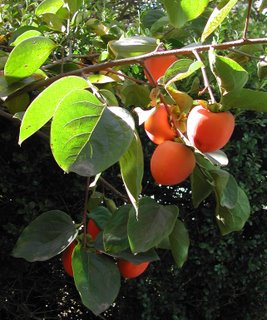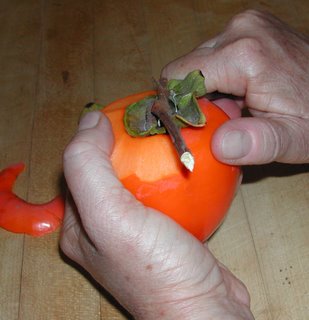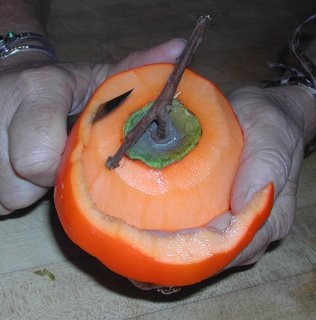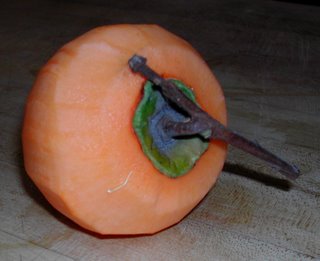Saturday, November 18, 2006
Thursday, November 16, 2006
Hoshi Gaki
The peeled persimmons hang for a couple of days before you start massaging them. The outer flesh firms up and the inside begins to soften. You press them, rolling the inside a bit to move the moist pulp around.
Notice one is enclosed in a cheesecloth sling. The stem came off that one. The cheesecloth has worked just fine.

You hang them in groups of two, looping a doubled string over the stems. Arrange them so one hangs higher than the other and place them next to each other alternating high and low.
Usually you hang them from a bamboo pole, but I decided my garden window would work just fine.
I can open the windows on either side to get a little cross ventilation to help them dry.

This is after the first day of hanging. The outer flesh is beginning to look a little papery and not so taut.
It's supposed to take about 3 to 4 weeks of massage every two or three days. Mine are moving along a lot faster. It may be because they are in the window.
I haven't taken any pictures lately because I've been so busy trying to keep them all massaged. We probably have 50 hanging in the kitchen right now.
Yesterday we tasted one that had reached the stage of rich candy-like sweetness, moist but not gooshy. It was incredible. Dave tasted one today and decided to hang another rack so we can make a lot more.
A sugary bloom begins to collect on the outside as they get to this luscious dried state.
A Tree Full of Persimmons
 It's that time of year in So. California when the Persimmon trees are laden with fruit and you realize you only need a couple of persimmon puddings for the holidays, so what the heck are you going to do with all those persimmons.
It's that time of year in So. California when the Persimmon trees are laden with fruit and you realize you only need a couple of persimmon puddings for the holidays, so what the heck are you going to do with all those persimmons.I've tried freezing them whole like billiard balls (in case I need a batch of persimmon bread or cookies during the year), but I already have a freezer filled with persimmon balls and no room for anything else. So when I heard about a persimmon massage class that our local Slow Food group was giving, I decided that might be the solution.
Apparently massaged persimmons yield luscious dried fruit far superior to other dried forms and in Japan when Hoshi Gaki (the massaged fruit) is given as a gift at New Years, it's considered a special treasure and is said to bring good luck. So here's a lovely way to distribute excess fruit to your friends at the end of the holidays.
First you pick firm persimmons leaving the stem attached to the fruit. In fact, in Japan, they usually break off part of the branch that the stem is attached to, so you get a little "t" at the top.

You'll need a small paring knife to remove the top, leaving the stem and part of the calyx.
If you rest the tip of the knife against the front side of the stem and then rotate the persimmon as you cut, you should get a nice flat top.
"Should" is the operative word here. but with a little practice they'll be flat and the ones that aren't smooth are still going to be delicious.

The next step is to hold your knife at a 45 degree angle and peel around the top edge to make a shoulder on the fruit.
I'm not sure why this is important but it gives the fruit a nice artistic look and in Japanese culture that is usually reason enough.

At this point you can use your peeler to remove the rest of the skin.
Peel lightly and only peel over the tip once. Any thin places run the risk of breaking before the inner pulp is dried and allowing it to leak out.
The outside will become sort of leathery and will form a bag to hold the moister interior as you massage it. The purpose of the massage is to move the moisture around to help the persimmon dry evenly.

This persimmon is peeled and ready to hang. But since I have 30 bries to deliver this morning, you're going to have to wait for the next blog update to see how to line them up for massage.
In the meantime, you can go to Jeff Reiger's Hoshi Gaki page at Penryn Orchard Specialties. Jeff was our teacher at the Slow Food class and he sells a variety of persimmons as well as his own hoshi gaki.
Subscribe to:
Posts (Atom)




